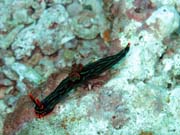 Colorful sea slugs and nudibranchs can be found in both tropical and temperate seas. Nudibranchs are members of soft-bodied shell-less marine sea slug group opisthobranch gastropod mollusks, which are known for their extremely bright marvelous colors and extraordinary forms. Among this group, there can be found the most colorful creatures on earth. The researches shows, during the evolution sea slugs have lost their shell because they have developed other defense mechanisms. Their anatomy can copy the texture and color of the surrounding plants, allowing them to camouflage. Others, as seen especially well on Chromodorids, have an intense and bright coloring, which warns that they are distasteful or even poisonous.
Colorful sea slugs and nudibranchs can be found in both tropical and temperate seas. Nudibranchs are members of soft-bodied shell-less marine sea slug group opisthobranch gastropod mollusks, which are known for their extremely bright marvelous colors and extraordinary forms. Among this group, there can be found the most colorful creatures on earth. The researches shows, during the evolution sea slugs have lost their shell because they have developed other defense mechanisms. Their anatomy can copy the texture and color of the surrounding plants, allowing them to camouflage. Others, as seen especially well on Chromodorids, have an intense and bright coloring, which warns that they are distasteful or even poisonous.
 Nudibranchs live at all depths, but reaching their greatest size and variation in warm, shallow waters. They are hermaphroditic, and thus have a set of reproductive organs for both genders, but they can rarely fertilize themselves. Nudibranchs typically deposit their eggs within a gelatinous spiral.
Nudibranchs live at all depths, but reaching their greatest size and variation in warm, shallow waters. They are hermaphroditic, and thus have a set of reproductive organs for both genders, but they can rarely fertilize themselves. Nudibranchs typically deposit their eggs within a gelatinous spiral.
 All the nudibranchs have primitive eyes which make them only able to distinguish the changes of light. The olfactory receptors are placed in the characteristic horns rinoholes which have a variety of forms. The rinoholes are used as sensors to feel vibrations and changes of pressure of the water. The primitive ear appears to be providing rather the space orientation. Finally all the nudibranchs have head tentacles sensitive to touch, taste, and smell. They use them to feel the surrounding environment.
All the nudibranchs have primitive eyes which make them only able to distinguish the changes of light. The olfactory receptors are placed in the characteristic horns rinoholes which have a variety of forms. The rinoholes are used as sensors to feel vibrations and changes of pressure of the water. The primitive ear appears to be providing rather the space orientation. Finally all the nudibranchs have head tentacles sensitive to touch, taste, and smell. They use them to feel the surrounding environment.
 While many opistobranches are vegetarian, the nudibranchs are carnivorous highly specialized that feed on a specific source of food although as a group they feed on a vast range of foods that vary from various forms of animal tissues, to fishes, eggs of other nudibranches, to the cannibalism towards their own similar. Apart the rare cases in which the nudibranches become a food for people at Aleutian Islands, the nudibranchs are rarely served as food.
While many opistobranches are vegetarian, the nudibranchs are carnivorous highly specialized that feed on a specific source of food although as a group they feed on a vast range of foods that vary from various forms of animal tissues, to fishes, eggs of other nudibranches, to the cannibalism towards their own similar. Apart the rare cases in which the nudibranches become a food for people at Aleutian Islands, the nudibranchs are rarely served as food.